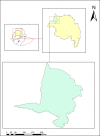Malaria Infection is High at Transit and Destination Phases Among Seasonal Migrant Workers in Development Corridors of Northwest Ethiopia: A Repeated Cross-Sectional Study
- PMID: 34079425
- PMCID: PMC8165298
- DOI: 10.2147/RRTM.S306001
Malaria Infection is High at Transit and Destination Phases Among Seasonal Migrant Workers in Development Corridors of Northwest Ethiopia: A Repeated Cross-Sectional Study
Abstract
Purpose: Malaria is a leading public health problem in Ethiopia. Every year, thousands of seasonal farm workers travel to farm corridors in Northwest Ethiopia and fall at risk of malaria infection. However, the magnitude of malaria infection and risk factors during harvest time were not well identified. This study aimed at estimating the prevalence and risk factors of malaria infection among seasonal migrant workers in Northwest Ethiopia.
Methods: A repeated cross-sectional study was conducted at transit and destination phases in Metema district from September 15, 2018 to October 30, 2019. Data were collected using a structured questionnaire. A capillary blood sample was collected to examine infection with malaria parasite using a microscope. A multivariate logistic regression technique was used to determine risk factors.
Results: The malaria prevalence at transit and destination phases among migrant workers was 13.5% (95% CI: 12.07-14.93%) and 18.7% (95% CI: 16.40-21.02%), respectively. The combined prevalence was 16.1% (95% CI: 14.67-17.63%). The odds of malaria infection among migrant workers at the destination phase was 1.5 (OR=1.5, 95% CI 1.167-1.846) times higher compared to the transit phase. Education (AOR=8.198; 95% CI: 4.318-15.564), knowledge of antimalarial drugs (AOR=2.4; 95% CI: 1.43-3.95), and use of long-lasting insecticidal nets (AOR=5.0; 95% CI: 3.34-4.43) were significantly associated with malaria infection at migration phases.
Conclusion: This study showed that the burden of malaria among seasonal migrant workers was high at transit and destination phases. Malaria prevalence was higher at the destination phase compared to the transit phase. A tailored malaria prevention intervention is needed including awareness creation, screening, treatment, repellent, and prophylaxis at both phases to reduce malaria infections.
Keywords: destination; malaria; malaria prevalence; seasonal migrant farm workers; transit.
© 2021 Tilaye et al.
Conflict of interest statement
The authors report no conflicts of interest in this work.
Figures
Similar articles
-
Perceived causes and solutions for malaria prevalence among seasonal migrant workers in Northwest Ethiopia: a qualitative study.Malar J. 2025 Feb 17;24(1):47. doi: 10.1186/s12936-024-05231-3. Malar J. 2025. PMID: 39962574 Free PMC article.
-
High asymptomatic malaria among seasonal migrant workers departing to home from malaria endemic areas in northwest Ethiopia.Malar J. 2022 Jun 11;21(1):184. doi: 10.1186/s12936-022-04211-9. Malar J. 2022. PMID: 35690823 Free PMC article.
-
Low practice of malaria prevention among migrants and seasonal farmworkers in Metema and west Armacheho districts, Northwest Ethiopia.BMC Infect Dis. 2021 Feb 4;21(1):145. doi: 10.1186/s12879-021-05853-x. BMC Infect Dis. 2021. PMID: 33541286 Free PMC article.
-
Access to malaria prevention and control interventions among seasonal migrant workers: A multi-region formative assessment in Ethiopia.PLoS One. 2021 Feb 23;16(2):e0246251. doi: 10.1371/journal.pone.0246251. eCollection 2021. PLoS One. 2021. PMID: 33621245 Free PMC article.
-
Malaria prevention and treatment in migrant agricultural workers in Dangur district, Benishangul-Gumuz, Ethiopia: social and behavioural aspects.Malar J. 2021 May 19;20(1):224. doi: 10.1186/s12936-021-03766-3. Malar J. 2021. PMID: 34011347 Free PMC article.
Cited by
-
Migrants and Healthcare during COVID-19, the Case of Kanchanaburi Province in Thailand.Healthcare (Basel). 2023 Oct 13;11(20):2724. doi: 10.3390/healthcare11202724. Healthcare (Basel). 2023. PMID: 37893798 Free PMC article.
-
Perceived causes and solutions for malaria prevalence among seasonal migrant workers in Northwest Ethiopia: a qualitative study.Malar J. 2025 Feb 17;24(1):47. doi: 10.1186/s12936-024-05231-3. Malar J. 2025. PMID: 39962574 Free PMC article.
-
Pooled prevalence of malaria and associated factors among vulnerable populations in Ethiopia: a systematic review and meta-analysis.BMC Infect Dis. 2024 Aug 15;24(1):828. doi: 10.1186/s12879-024-09736-9. BMC Infect Dis. 2024. PMID: 39148027 Free PMC article.
-
A cross-sectional study investigating malaria prevalence and associated predictors of infection among migrants to a newly established gold mining settlement in the Gambella Region of Ethiopia.Malar J. 2024 Sep 30;23(1):292. doi: 10.1186/s12936-024-05117-4. Malar J. 2024. PMID: 39350117 Free PMC article.
-
High connectivity and low differentiation of Plasmodium falciparum parasite populations in a setting with high seasonal migration.Res Sq [Preprint]. 2025 Jul 2:rs.3.rs-6771360. doi: 10.21203/rs.3.rs-6771360/v1. Res Sq. 2025. PMID: 40630523 Free PMC article. Preprint.
References
-
- World Health Organization. World Malaria Report 2014. Geneva, Switzerland: World Health Organization; 2014.
-
- World Health Organization. World Malaria Report 2019. Geneva, Switzerland: World Health Organization; 2019.
-
- WHO. World Malaria Report 2020. 20 years of global progress and challenges. Geneva, Switzerland: WHO; 2020.
LinkOut - more resources
Full Text Sources


